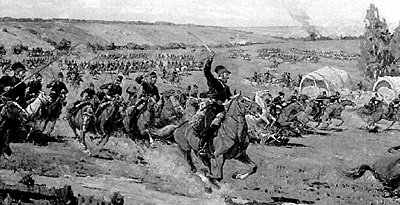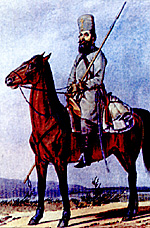Peter Bagration:
The Best Georgian General
of the Napoleonic Wars
Part 2: First Victory:
Platov in Action Around Mir
By Alexander Mikaberidze,
Chairman of the Napoleonic Society of Georgia
| |
Notifying Platov of the transfer of his Cossacks in the 2nd Western Army, Bagration ordered to him to depart for Novogrudok, Stvolichi, and Snov from whence the Cossacks would cover a concentration of army in Nesvij; afterwards Platov was to follow to Nesvij serving as a rearguard for Bagration's army. Platov received Bagration's order on the evening of June 26, when his troops were already approaching to the Mir, and Novogrudok was already in hands of the enemy. With a view to covering Nesvij from the west, Platov sent to Polonechki and Snov three units of Cossacks, totalling some 1500, under command of Major-General Karpov. Platov acknowledged his new superior and informed Bagration of his actions. The latter, approved and ordered Platov to pay special attention to necessity to safeguarding Mir. Only in case of the significant superiority of enemy forces was Platov authorised to retire on Nesvij. Platov's occupation of Mir could provide to the main forces of 2nd Western Army an opportunity to rest. With receipt of the order indicating the importance of covering Mir, Platov began its immediate execution. He decided to apply his favourite tactical disposition, the so-called "Venter". The essence of this method was to entice the enemy in an ambush, and then to strike on him from different directions, to surround and destroy. By June 27, near Mir, on the direct order of Platov, there were gathered several units of Cossacks and a unit of mounted artillery. He put one unit of Cossacks in Mir, and others were deployed to the south from Mir, in a grove near Jablonovshina. Ahead of Mir, on road from Karelichi, 100 Cossacks were put in position. Two hundred more Cossacks were placed in ambush, hidden on both sides of the road. In the early morning of June 27, advancing on Mir, the brigade under the command of General Turno from the 4th Division of Light Cavalry, of the VI Cavalry Corps, had gone over to the offensive. The leading three squadrons of the 3rd Uhlan Brigade moved up the road to Mir one after another, with the remaining regiments, the 15th and 16th Polish Lancers following in their wake. As the first uhlan squadron approached the visible Cossacks, the latter made a hasty departure toward Mir. The French imperial cavalry immediately pursued the Cossacks and rushed into Mir. In the southern suburbs, the retiring Cossacks turned and together with another Cossack Regiment, counterattacked the pursuers. The uhlans were overturned and forced into a chaotic flight. It was now that hundreds of Cossacks struck the fleeing uhlans from the flanks and front. Most of the leading elements of the 3rd Uhlan Brigade were surrounded and almost completely destroyed. Only fragmentary remains of the brigade were able to break from away from the ambush. To the aid of the 3rd Brigade's advance guard, General Turno directed three more uhlan squadrons. However, the arrival of fresh forces did not rescue the situation. The uhlans again suffered defeat by a vigorous attack and ran in a panic. In this fight at Mir on June 27, were involved about four thousand Russian troops and over two thousand French. French casualties included 8 officers lost and 348 private soldiers killed, wounded or in captivity. Russian losses amounted to 25 killed and wounded. When news of the contact and route at Mir reached the 2nd Uhlan Brigade, the French command set other forces of 4th Division of Light Cavalry against Platov's squadrons. On receiving Platov's official report about the fight, Bagration instructed him to maintain the defence against the enemy at Mir to the last. To strengthen Platov, Bagration reinforced him with Vasilchikov's command of three cavalry units. Next day, Platov decided to repeat the tactical disposition that had succeeded so excellently in the fight of June 27. To this end, he positioned the rear guard (three regiments of Cossacks) on road south of Mir to entice the enemy, while establishing his main forces south-west of Simkovo, with the task of striking the enemy in the flank. Further, Bagration sent orders to Kuteynikov's Brigade which, following Dorokhov's Division, had reached Stolbtsi by this time, instructing it to move immediately to Simkovo in order to take part, together with main forces, in the envelopment and destruction of the enemy's forces. The enemy had considered the lessons of the June 27 fight at Mir, however, and, being afraid of an ambush, showed care. This time in pursuit of the Russian rear guard, the French command directed only 7th Regiment of 1st Brigade, while other forces of 4th Division of light cavalry stopped at Simakov (most of the 2nd Brigade settled down in the south-west suburb and the 2nd Regiment, along with the 11th Regiment of the 1st Brigade, positioned themselves in a northern suburb.)
The French command sent forward to the aid of the 7th Regiment a squadron of the 2nd Uhlan Brigade, which had been held in reserve. Moreover, it deployed the 11th Uhlan Regiment and one squadron of the 16th Uhlan Regiment to the left of the road. The 2nd Uhlan Regiment (settled down to the north of Simakov), minus a squadron, continued in reserve. By these actions, the French command managed to counter the threat of being cut off. French forces fiercely resisted the attacks launched by Platov's main forces. Persistent fighting continued for some six hours. In spite of vigorous efforts on both sides, neither could gain a decisive advantage. At 9:00 PM, Kuteynikov's Brigade arrived in the field, after a forced marched from Stolbtsy. Having deployed between the villages of Podlesye and Ozersk, the brigade entered directly into fight, suddenly attacking the enemy's left flank and rear. Simultaneously, the Cossack main force struck from the front and the right flank. The enemy was unable to sustain the co-ordinated impact and broke in chaotic flight with the Cossacks in vigorous pursuit. During operations around Mir on June 28, Belorussian peasant Denis, an inhabitant of village Simakovo, particularly distinguished himself. He had been sent, together with a group of Cossacks, to lead Kuteynikov's Brigade from Stolbtsy to the battlefield. Denis had carried out this task with exemplary courage and success, leading the brigade by the shortest way, which was well known to him, and thereby greatly aided its vital contribution to the contest at Mir. In fighting of June 27 and 28 around Mir, the Platov's forces crushed nine French units. It was the first victory of Russian arms during the Great Patriotic war of 1812. This victory instilled in the Russian army a confidence in its abilities and, having detained the enemy at Mir, allowed to 2nd Western Army to obtain a much needed rest in Nesvij and to prepare itself for the continued movement to Bobruisk. More Peter Bagration
Part 1: 1799-1810 Part 1: Preparations for the French Invasion of Russia Part 1: War Plans Part 2: Change of Plans
Part 3: Withdrawal and Guerrilla War
Back to Table of Contents -- First Empire #54 Back to First Empire List of Issues Back to MagWeb Master Magazine List © Copyright 2000 by First Empire. This article appears in MagWeb (Magazine Web) on the Internet World Wide Web. Other military history articles and gaming articles are available at http://www.magweb.com |

 Faced with this situation, Platov changed his initial plan, deciding to crush the enemy by a courageous and vigorous attack. Under his order at 1:00 PM, parts of the former rear guard, composed of one Cossack unit, the Akhtyrsk Hussars, Kiev Dragoons, and the 2nd Don Horse-battery, attacked the 7th Uhlan Regiment, throwing it back into Simakov. Simultaneously, the main force of Cossacks attacked the 2nd Uhlan Brigade. The approach of Russian forces at once threatened to cut off the French left flank.
Faced with this situation, Platov changed his initial plan, deciding to crush the enemy by a courageous and vigorous attack. Under his order at 1:00 PM, parts of the former rear guard, composed of one Cossack unit, the Akhtyrsk Hussars, Kiev Dragoons, and the 2nd Don Horse-battery, attacked the 7th Uhlan Regiment, throwing it back into Simakov. Simultaneously, the main force of Cossacks attacked the 2nd Uhlan Brigade. The approach of Russian forces at once threatened to cut off the French left flank.